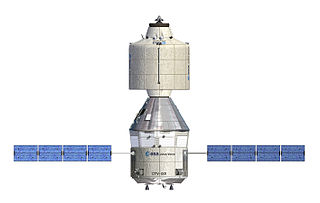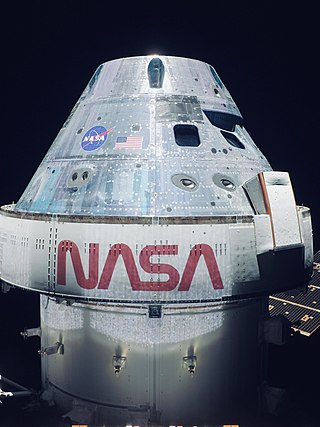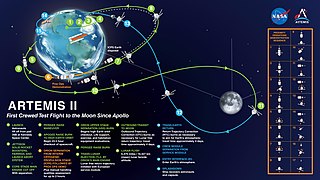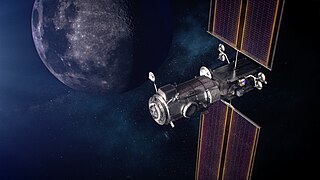Human spaceflight programs have been conducted, started, or planned by multiple countries and companies. Until the 21st century, human spaceflight programs were sponsored exclusively by governments, through either the military or civilian space agencies. With the launch of the privately funded SpaceShipOne in 2004, a new category of human spaceflight programs – commercial human spaceflight – arrived. By the end of 2022, three countries and one private company (SpaceX) had successfully launched humans to Earth orbit, and two private companies had launched humans on a suborbital trajectory.

The Automated Transfer Vehicle, originally Ariane Transfer Vehicle or ATV, was an expendable cargo spacecraft developed by the European Space Agency (ESA), used for space cargo transport in 2008–2015. The ATV design was launched to orbit five times, exclusively by the Ariane 5 heavy-lift launch vehicle. It effectively was a larger European counterpart to the Russian Progress cargo spacecraft for carrying upmass to a single destination—the International Space Station (ISS)—but with three times the capacity.

The Constellation program was a crewed spaceflight program developed by NASA, the space agency of the United States, from 2005 to 2009. The major goals of the program were "completion of the International Space Station" and a "return to the Moon no later than 2020" with a crewed flight to the planet Mars as the ultimate goal. The program's logo reflected the three stages of the program: the Earth (ISS), the Moon, and finally Mars—while the Mars goal also found expression in the name given to the program's booster rockets: Ares. The technological aims of the program included the regaining of significant astronaut experience beyond low Earth orbit and the development of technologies necessary to enable sustained human presence on other planetary bodies.
A service module is a component of a crewed space capsule containing a variety of support systems used for spacecraft operations. Usually located in the uninhabited area of the spacecraft, the service module serves a storehouse of critical subsystems and supplies for the mission such as electrical systems, environmental control, and propellant tanks. The service module is jettisoned upon the completion of the mission, and usually burns up during atmospheric reentry.

The Exploration Systems Architecture Study (ESAS) is the official title of a large-scale, system level study released by the National Aeronautics and Space Administration (NASA) in November 2005 of his goal of returning astronauts to the Moon and eventually Mars—known as the Vision for Space Exploration. The Constellation Program was cancelled in 2010 by the Obama Administration and replaced with the Space Launch System, later renamed as the Artemis Program in 2017 under the Trump Administration.

Crew Space Transportation System (CSTS), or Advanced Crew Transportation System (ACTS), was a proposed design for a crewed spacecraft for low Earth orbit operations such as servicing the International Space Station, but also capable of exploration of the Moon and beyond. It was originally a joint project between the European Space Agency (ESA) and the Roscosmos, but later became solely an ESA project. This study was conceived as a basic strategic plan to keep a viable European human spaceflight program alive.

The Crew Exploration Vehicle (CEV) was a component of the U.S. NASA Vision for Space Exploration plan. A competition was held to design a spacecraft that could carry humans to the destinations envisioned by the plan. The winning design was the Orion spacecraft.

The National Aeronautics and Space Administration is an independent agency of the U.S. federal government responsible for the civil space program, aeronautics research, and space research. Established in 1958, it succeeded the National Advisory Committee for Aeronautics (NACA) to give the U.S. space development effort a distinct civilian orientation, emphasizing peaceful applications in space science. It has since led most of America's space exploration programs, including Project Mercury, Project Gemini, the 1968–1972 Apollo Moon landing missions, the Skylab space station, and the Space Shuttle. Currently, NASA supports the International Space Station (ISS) along with the Commercial Crew Program, and oversees the development of the Orion spacecraft and the Space Launch System for the lunar Artemis program.

The retirement of NASA's Space Shuttle fleet took place from March to July 2011. Discovery was the first of the three active Space Shuttles to be retired, completing its final mission on March 9, 2011; Endeavour did so on June 1. The final shuttle mission was completed with the landing of Atlantis on July 21, 2011, closing the 30-year Space Shuttle program.

Orion is a partially reusable crewed spacecraft used in NASA's Artemis program. The spacecraft consists of a Crew Module (CM) space capsule designed by Lockheed Martin and the European Service Module (ESM) manufactured by Airbus Defence and Space. Capable of supporting a crew of four beyond low Earth orbit, Orion can last up to 21 days undocked and up to six months docked. It is equipped with solar panels, an automated docking system, and glass cockpit interfaces modeled after those used in the Boeing 787 Dreamliner. A single AJ10 engine provides the spacecraft's primary propulsion, while eight R-4D-11 engines, and six pods of custom reaction control system engines developed by Airbus, provide the spacecraft's secondary propulsion. Orion is intended to be launched atop a Space Launch System (SLS) rocket, with a tower launch escape system.
The European System Providing Refueling Infrastructure and Telecommunications (ESPRIT) is an under construction module of the Lunar Gateway. It will provide refueling through additional xenon and hydrazine capacity for use in the Power and Propulsion Element's ion engines and hydrazine thrusters. It will also provide additional communications equipment, a habitation area, and storage. It will have a launch mass of approximately 10,000 kg (22,000 lb), a length of 6.4 m (21 ft), and a diameter of 4.6 m (15 ft). ESA awarded two parallel design studies for ESPRIT, one mostly led by Airbus in partnership with Comex and OHB and one led by Thales Alenia Space. The construction of the module was approved in November 2019. On 14 October 2020, Thales Alenia Space announced that they had been selected by ESA to build the ESPRIT module.

Artemis 1, officially Artemis I and formerly Exploration Mission-1 (EM-1), was an uncrewed Moon-orbiting mission. As the first major spaceflight of NASA's Artemis program, Artemis 1 marked the agency's return to lunar exploration after the conclusion of the Apollo program five decades earlier. It was the first integrated flight test of the Orion spacecraft and Space Launch System (SLS) rocket, and its main objective was to test the Orion spacecraft, especially its heat shield, in preparation for subsequent Artemis missions. These missions seek to reestablish a human presence on the Moon and demonstrate technologies and business approaches needed for future scientific studies, including exploration of Mars.
Airbus Defence and Space is a division of Airbus SE. It is responsible for the development and manufacturing of defence and space products, and providing related services. The division was formed in January 2014 during the corporate restructuring of European Aeronautic Defence and Space (EADS) into Airbus SE, and comprises the former Airbus Military, Astrium, and Cassidian divisions. It is said to be the second largest space company in the world.

Artemis 2 is a scheduled mission of the NASA-led Artemis program. It will use the second launch of the Space Launch System (SLS) and include the first crewed mission of the Orion spacecraft. The mission is scheduled for no earlier than September 2025. Four astronauts will perform a flyby of the Moon and return to Earth, becoming the first crew to travel beyond low Earth orbit since Apollo 17 in 1972. Artemis 2 will be the first crewed launch from Launch Complex 39B of the Kennedy Space Center since STS-116 in 2006.

The Lunar Gateway, or simply Gateway, is a space station which Artemis program participants plan to assemble in an orbit near the Moon. The Gateway is intended to serve as a communication hub, science laboratory, and habitation module for astronauts. It is a multinational collaborative project: participants include NASA, the European Space Agency (ESA), the Japan Aerospace Exploration Agency (JAXA), the Canadian Space Agency (CSA) and the Mohammed Bin Rashid Space Centre (MBRSC). The Gateway is planned to be the first space station beyond low Earth orbit.

The Artemis program is a Moon exploration program that is led by the United States' National Aeronoautics and Space Administration (NASA) and was formally established in 2017 via Space Policy Directive 1. The Artemis program is intended to reestablish a human presence on the Moon for the first time since the Apollo 17 moon mission in 1972. The program's stated long-term goal is to establish a permanent base on the Moon to facilitate human missions to Mars.

Artemis 4 is a planned mission of the NASA-led Artemis program. The mission will include the fourth use of a Space Launch System (SLS) launch vehicle, will send an Orion spacecraft with four astronauts to the Lunar Gateway space station, install a new module on the Gateway, and conduct the second lunar landing of the Artemis program.

The International Habitation Module, International Habitat or I-HAB is designed as a habitat module of the Lunar Gateway station, to be built by the European Space Agency (ESA) in collaboration with the Japan Aerospace Exploration Agency, or JAXA. The I-HAB will have a maximum launch mass of 10,000 kg (22,000 lb) and provide a habitable volume of 10 m3 (350 cu ft).

























